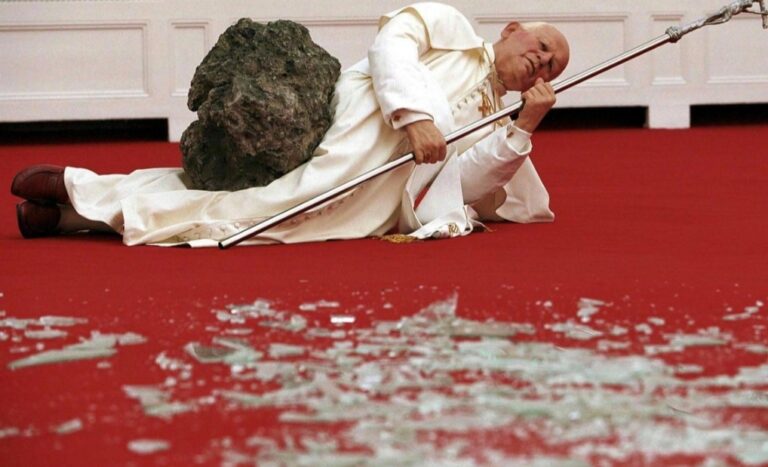
VENTURA PROFANA, 2020.
Untitled, Digital Collage, 90 x 140 cm.
In her solo show in Oslo in the second half of 2021, Brazilian artist Ventura Profana, recent winner of the Pipa Prize, exhibited this work that defiantly dialogues with papal representation in the history of art. From Tiziano's decrepit pontiff, to Francis Bacon's frightening reinterpretation of Velásquez, to Maurizio Catelan's impressive sculpture of John Paul II struck by a meteor and, finally, remembering Glenn Brown's Pope “à la Baselitz” in “Nausea ” (currently at Tate Liverpool), VENTURA PROFANA – in his collage – rewrites the history of criticism of an ancient symbol.




In the simple and original gesture of placing a centuries-old hieratic and frontal figure with its back to the public, the artist shifts meanings and elaborates metaphors. Who is this figure? Is it a contemporary representation of the strange Ratzinger/Francisco binomial? If not, who will? Which of the successors, since the exchange of purple for white in the 16th century, represents this man (in) white? What speeches and actions does it refer to? It doesn't matter: Ventura Profana gives us back the shepherd of humanity, the crowd stirrer and political figure of an eternal messianic becoming as a solitary and tiny eyewitness of a colossal (colonial?) past.
In the critical tradition of Tiziano, Bacon, Catelan and Brown, Ventura Profana presents us with the Pope in an inexorable reckoning with History. This is what many are waiting for, as the editor-in-chief of the German magazine EMMA, Alice Schwarzer, demonstrated at the end of the year, who named the Pope the “Most Sexist Man of 2021”. Ventura was prophetic. Curator Felipe Pena, organizer of the show at the Tenthaus space – who together with Ana Elisa Cohen is in charge of Galeria Cavalo in Botafogo – named the artist in his critical text as a “missionary”. Pena wrote that she gave him “faith in a land where I want my daughters to feel at home, through something I hope to see more of in religion: acceptance and courage to change the world.” With a lot of hate, but also a lot of love.” Norwegian critic Andreas Breivik, in his text about the expo in Nordic Art Review, made valuable connections between Ventura's work and the writings of Donna Haraway and Paul Preciado: but he also made intricate observations about the exhibition. We, like Felipe and Andreas, also had the most disconcerting ideas and elaborate interpretations; We spent hours discussing the artist's motives and powerful syntheses – which inspire hope in a Brazil that has become purgatory.
Faced with a work that is exceptional to say the least, we close with Felipe and turn, “with a lot of hate, but also with a lot of love”, to a biblical quote from the Apostle John, the same one from Revelation, which could illustrate the artist:
“He who hates his brother is in darkness, and walks in darkness, and does not know where he should go; because darkness blinded his eyes”(2;11).
Here's the deal: Ventura Profana has fiery eyes, wide open.